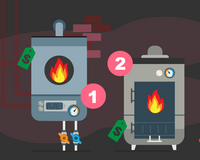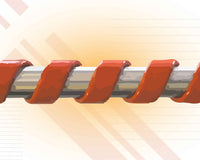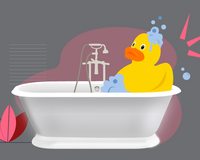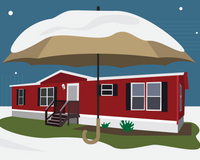With hoodie season comes heating season! As the last leaves drop, your mobile home furnace must stay up to task. Before you invest in replacing a mobile home furnace in its entirety, it’s important to realize that a failed or defective part could be causing your woes. The ability to differentiate between minor and major issues could literally mean a difference of hundreds of dollars.
So let’s try to answer the question: “When do I absolutely need a new mobile home furnace?”
Is your ductwork clean?
Before you replace anything, be aware that excessive build-up and debris in your HVAC ductwork are a huge detriment to mobile home furnace efficiency. Dirty or clogged-up ventilation can harbor allergens and pathogens and may even pose a fire hazard!
Although HVAC cleaning and maintenance should always be on your mobile home spring cleaning docket, it’s not too late to make amends. Before beginning, power down the HVAC system and remove the vent and register covers. Vacuum out as much dirt and debris as you can (a hose attachment will help your reach).
For the best results, you’ll need to crawl under your mobile home and detach the ductwork so it can be sanitized, scrubbed, and rinsed out. Make sure the ducts are completely dried and insulated before reattaching. We recommend waiting for a nice day to do this or hiring a professional cleaning service.
And don’t forget to replace your air filter!
Mobile home furnace troubleshooting
If cleaning out your mobile home furnace doesn’t do the trick, then you may be looking at repairs. Luckily, many of these fixes are not as costly as you might think.
Newer furnaces
Newer furnaces are equipped with diagnostic systems that will indicate the problem with a blinking light. This will go a long way to eliminating the guesswork on your end!
If the burners aren’t lighting, the furnace ignitor is your first suspect. Upon activation, it should glow for at least five seconds. If the ignitor is fine but the burners still aren’t coming on, you may have a problem with the flame sensor or buildup in the burner orifice.
If clearing that out doesn’t help, try replacing the flame sensor. Otherwise, you may have a more complicated fix involving the blower assembly (which exchanges the air) and any of the many switches, circuits, or electronic components that help govern it. If you feel overwhelmed, do not hesitate to contact a technician!
Older furnaces
Older mobile home furnaces are a different beast. Most of them are equipped with a standing pilot light (small flame) that should stay lit all the time.
Start your diagnostics by ensuring the thermostat is set to “heat.” Then, check that the pilot light turns on and stays on. Make sure the gas valve knob is set to “pilot,” press and hold down the button on the valve, and light the pilot with a long match. Once lit, keep holding down the button for 30 seconds before slowly releasing pressure. You may have to repeat this a few times.
If that doesn’t work, it could be the thermocouple (metal temperature gauge that detects whether the pilot light is lit). Both of these components are inexpensive to replace, so they’re often purchased together.
Buying a new mobile home furnace
If you’ve exhausted all of your troubleshooting options and/or the age of your mobile furnace doesn’t justify the cost of repairs, it’s time to consider a new unit. Mobile home furnaces are not to be confused with those sold for conventional homes — they utilize a more condensed, specialized sealed combustion system designed to work in a smaller, more confined space. There are three main types.
Types of mobile home furnaces
-
Gas mobile home furnaces utilize propane or natural gas as a fuel source and are the best choice for most, with efficiency ratings of 80 to 95 percent and dependable operation.
-
Oil mobile home furnaces function by spraying a fine, controlled mist into the combustion chamber to be ignited. They’re a little cheaper to run than gas models, but they can be more difficult to maintain or find fuel for.
- Electric mobile home furnaces draw cold outdoor air into a heat exchanger, where it is warmed and dispersed throughout the home. They’re less expensive upfront, but may struggle to keep up with harsh northern winters due to the way they operate.
What kind of mobile home furnace is right for you?
When considering replacing a mobile home furnace, the most crucial factors are where you live geographically (climate, elevation, coastal vs. inland), utility access, the size and age of your home, and your current ducting and ventilation situation.
Look for a label or metal plate stating suitability for mobile home use, efficiency details, and BTU (British Thermal Unit) output. The higher the BTUs, the more quickly the furnace will be able to heat a room or a larger space. If you’re installing for the first time or changing systems, setup costs will be higher.
Shop new mobile home furnaces with Star Mobile!
If you are ready for a new mobile home furnace, Star Mobile Home Supply is proud to carry some of the industry’s best and most trusted brands, such as ThermoPride, Coleman, Revolv, and Nordyne. For safety, insurance, and warranty purposes, please be sure to hire a certified HVAC technician for installation. For all your heating and cooling needs and more, browse our full inventory.






